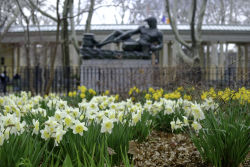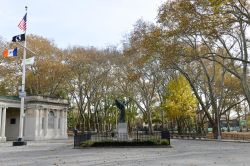Msgr. McGolrick Park
Monsignor McGolrick Park
What was here before?
The Keshaechqueren inhabited this forested land before European settlement arrived in 1638. The surrounding area remained sparsely occupied by several farming families until industrialization in the early 19th century.
Former New York Mayor Ambrose Kingsland (1804-1878) owned this property with his brother as part of a larger farmstead. Formerly a prosperous sperm whale oil merchant, as mayor Kingsland initiated the legislation that would enable the creation of Central Park. The brothers parceled and sold their land at great profit in the late 1800s.
How did this site become a park?
In 1889 the City of Brooklyn acquired the land for this park. It was originally named Winthrop Park, for Assemblyman Winthrop Jones, who was instrumental in obtaining the appropriation for the purchase and was the son of the Parks Department board members. A lifelong resident of Greenpoint, Jones co-owned a lumberyard at the corner of Kent and West Streets.
In 1891, the site was graded and fitted with a drainage system, and a new lawn was planted. By the end of the decade, Winthrop Park featured paved walks, new trees, shrubs, a shelter building, iron fences, and a novelty in recreation: boxes filled with "sea sand" for children. On Saturdays during the summer, neighborhood residents gathered in the park to hear band concerts. A playground was created in the park in 1897.
A handsome shelter pavilion was erected in the park in 1910. Designed by the architectural firm of Helmle and Huberty, the curved building of brick and limestone features an elegant wood colonnade. It is listed on the National Register and recognized as a New York City landmark. In 1985 the shelter pavilion was restored with a new roof, walkway repairs, graffiti removal, reconstruction of the colonnade, and replacement of windows and doors.
In 1985, the park's two monuments were restored. The World War I memorial (1923) south of the pavilion was designed by Carl Augustus Heber. It honors 150 Greenpoint soldiers who fought in World War I. The Monitor and the Merrimac (1939) by sculptor Antonio de Filippo, celebrates the battle of the ironclad USS Monitor and Confederate Merrimac on March 9, 1862, off the coast of Hampton Roads, Virginia. Designed by Swedish engineer John Ericcson, the Monitor was built at the Continental Iron Works in Greenpoint and outfitted at the Brooklyn Navy Yard.
Monsignor McGolrick Park was renovated in 1987, and again in 1995. In 2018 the playground received new play equipment, swings and a spray shower, café tables and seating, and new gated entryways throughout the playground. The park’s asphalt paths, benches and damaged sidewalks were reconstructed in 2023.
Who is this park named for?
In 1941 the park was renamed for Monsignor Edward J. McGolrick (1857-1938), who hailed from Dunnoughmore, County Donegal, Ireland. In 1888 Father McGolrick joined the parish of St. Cecilia's Roman Catholic Church, located on Herbert Street, where he served as pastor for fifty years. He was instrumental in the creation of a new church, convent, rectory, hospital, lyceum, school, and playing field.
Check out your park's Vital Signs
Clean & Safe
Green & Resilient
Empowered & Engaged Users
Share your feedback or learn more about how this park is part of a
Vital Park System







